A Critical Exploration of Mixed Methods in Educational Research
VerifiedAdded on 2022/10/19
|9
|2169
|384
Essay
AI Summary
This essay provides a critical exploration of mixed methods research, focusing on its application within the field of education. The introduction establishes the significance of mixed methods for studying complex educational data, highlighting the interconnected nature of research projects in this domain and outlining the paper's structure. The essay delves into the philosophical foundations of mixed methods, discussing the compatibility of qualitative and quantitative approaches, and the role of pragmatism. A review of relevant literature, including the work of Reid, Greaves, & Kirby (2017), is incorporated. The scope of mixed methods is then examined, emphasizing its utility in collecting, analyzing, and interpreting complex educational data. The strengths of the mixed methods approach, such as its ability to provide a comprehensive understanding and address the limitations of individual methods, are discussed. Conversely, the limitations, including the complexity of research design and potential challenges in data integration, are also addressed. The essay concludes with a summary of the advantages and disadvantages of mixed methods, and the importance of selecting research methods based on specific project requirements.

0
Critical Exploration Of Mixed Methods
Name of the Student
Name of the University
Author Note
Critical Exploration Of Mixed Methods
Name of the Student
Name of the University
Author Note
Paraphrase This Document
Need a fresh take? Get an instant paraphrase of this document with our AI Paraphraser
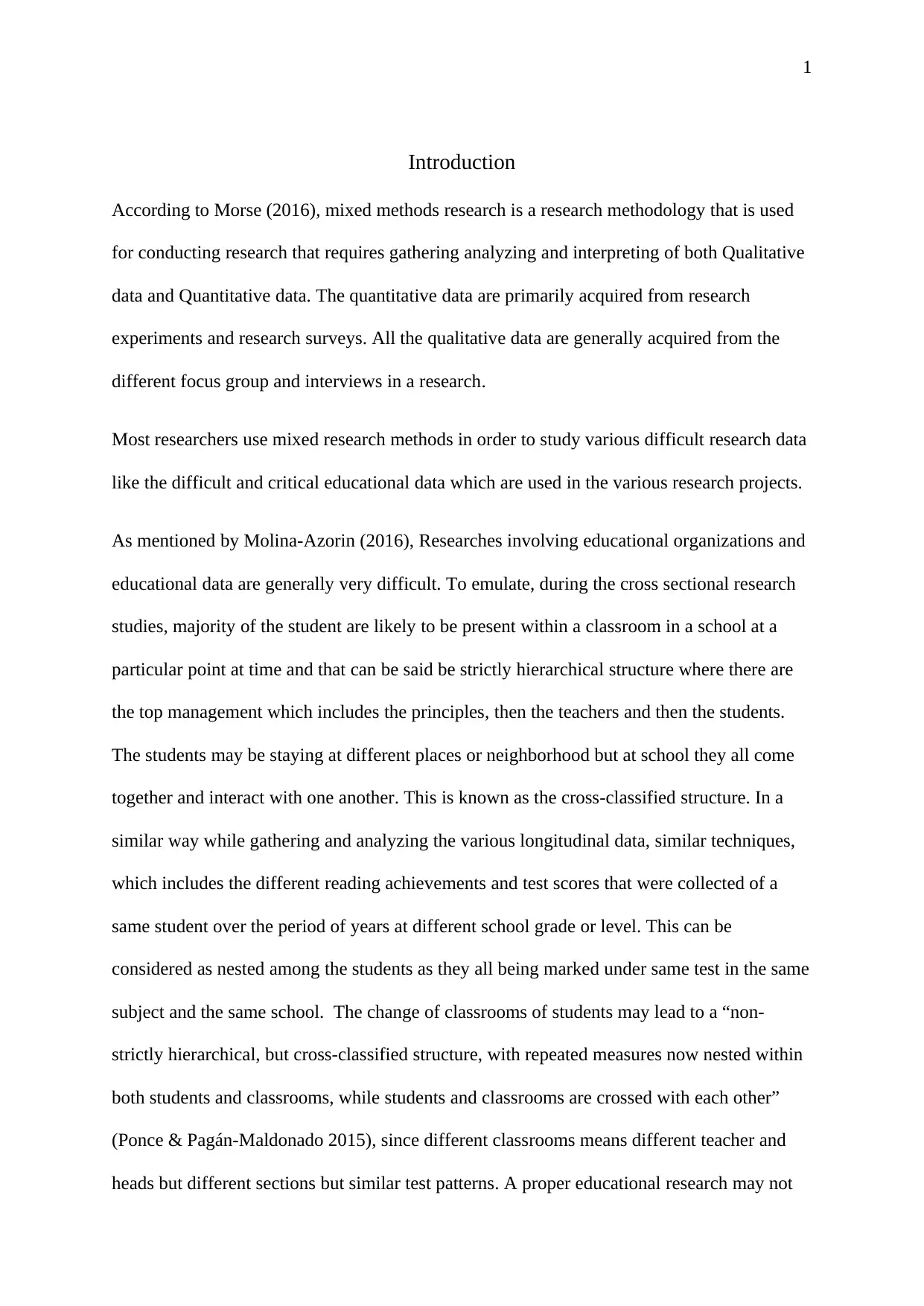
1
Introduction
According to Morse (2016), mixed methods research is a research methodology that is used
for conducting research that requires gathering analyzing and interpreting of both Qualitative
data and Quantitative data. The quantitative data are primarily acquired from research
experiments and research surveys. All the qualitative data are generally acquired from the
different focus group and interviews in a research.
Most researchers use mixed research methods in order to study various difficult research data
like the difficult and critical educational data which are used in the various research projects.
As mentioned by Molina-Azorin (2016), Researches involving educational organizations and
educational data are generally very difficult. To emulate, during the cross sectional research
studies, majority of the student are likely to be present within a classroom in a school at a
particular point at time and that can be said be strictly hierarchical structure where there are
the top management which includes the principles, then the teachers and then the students.
The students may be staying at different places or neighborhood but at school they all come
together and interact with one another. This is known as the cross-classified structure. In a
similar way while gathering and analyzing the various longitudinal data, similar techniques,
which includes the different reading achievements and test scores that were collected of a
same student over the period of years at different school grade or level. This can be
considered as nested among the students as they all being marked under same test in the same
subject and the same school. The change of classrooms of students may lead to a “non-
strictly hierarchical, but cross-classified structure, with repeated measures now nested within
both students and classrooms, while students and classrooms are crossed with each other”
(Ponce & Pagán-Maldonado 2015), since different classrooms means different teacher and
heads but different sections but similar test patterns. A proper educational research may not
Introduction
According to Morse (2016), mixed methods research is a research methodology that is used
for conducting research that requires gathering analyzing and interpreting of both Qualitative
data and Quantitative data. The quantitative data are primarily acquired from research
experiments and research surveys. All the qualitative data are generally acquired from the
different focus group and interviews in a research.
Most researchers use mixed research methods in order to study various difficult research data
like the difficult and critical educational data which are used in the various research projects.
As mentioned by Molina-Azorin (2016), Researches involving educational organizations and
educational data are generally very difficult. To emulate, during the cross sectional research
studies, majority of the student are likely to be present within a classroom in a school at a
particular point at time and that can be said be strictly hierarchical structure where there are
the top management which includes the principles, then the teachers and then the students.
The students may be staying at different places or neighborhood but at school they all come
together and interact with one another. This is known as the cross-classified structure. In a
similar way while gathering and analyzing the various longitudinal data, similar techniques,
which includes the different reading achievements and test scores that were collected of a
same student over the period of years at different school grade or level. This can be
considered as nested among the students as they all being marked under same test in the same
subject and the same school. The change of classrooms of students may lead to a “non-
strictly hierarchical, but cross-classified structure, with repeated measures now nested within
both students and classrooms, while students and classrooms are crossed with each other”
(Ponce & Pagán-Maldonado 2015), since different classrooms means different teacher and
heads but different sections but similar test patterns. A proper educational research may not
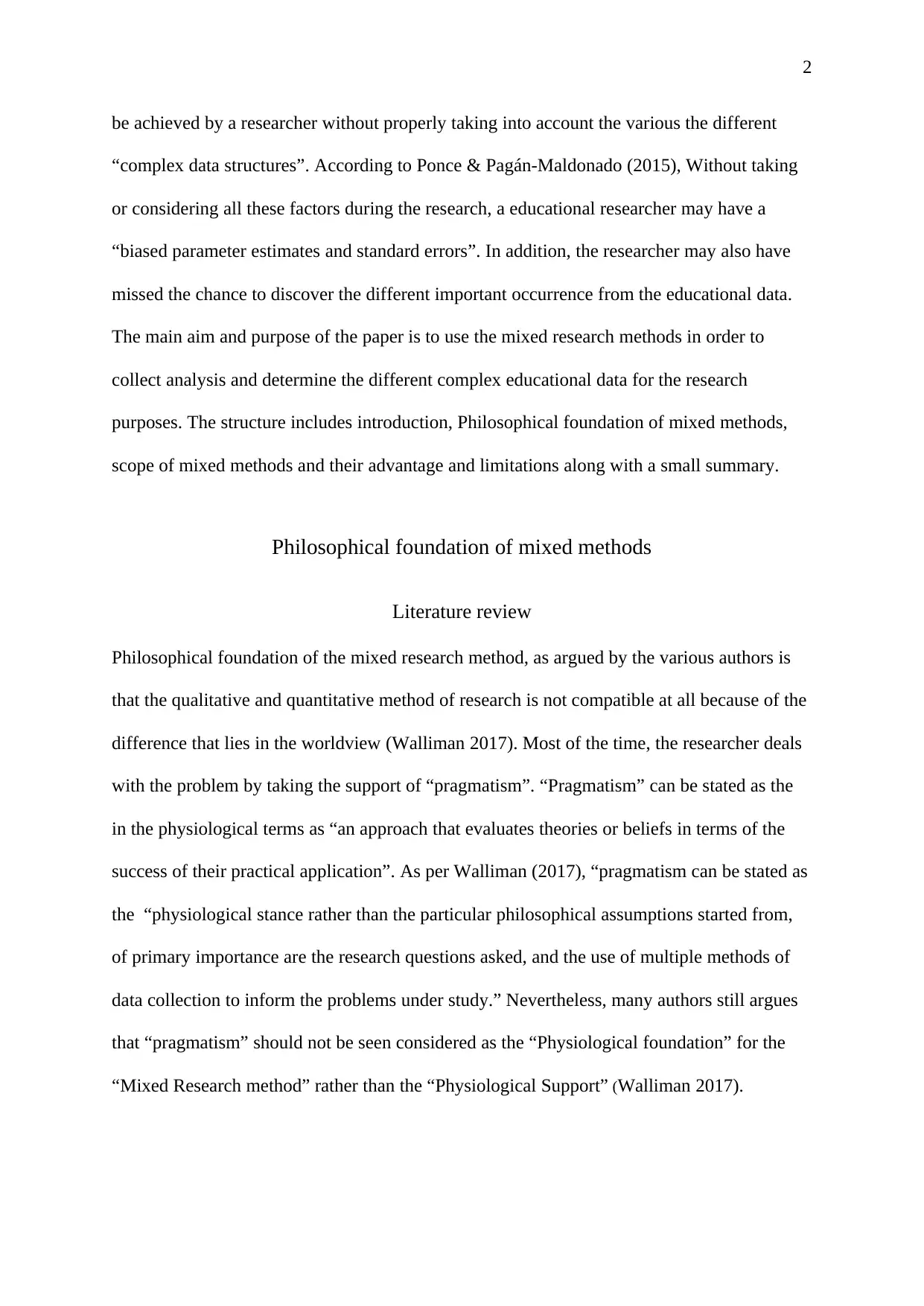
2
be achieved by a researcher without properly taking into account the various the different
“complex data structures”. According to Ponce & Pagán-Maldonado (2015), Without taking
or considering all these factors during the research, a educational researcher may have a
“biased parameter estimates and standard errors”. In addition, the researcher may also have
missed the chance to discover the different important occurrence from the educational data.
The main aim and purpose of the paper is to use the mixed research methods in order to
collect analysis and determine the different complex educational data for the research
purposes. The structure includes introduction, Philosophical foundation of mixed methods,
scope of mixed methods and their advantage and limitations along with a small summary.
Philosophical foundation of mixed methods
Literature review
Philosophical foundation of the mixed research method, as argued by the various authors is
that the qualitative and quantitative method of research is not compatible at all because of the
difference that lies in the worldview (Walliman 2017). Most of the time, the researcher deals
with the problem by taking the support of “pragmatism”. “Pragmatism” can be stated as the
in the physiological terms as “an approach that evaluates theories or beliefs in terms of the
success of their practical application”. As per Walliman (2017), “pragmatism can be stated as
the “physiological stance rather than the particular philosophical assumptions started from,
of primary importance are the research questions asked, and the use of multiple methods of
data collection to inform the problems under study.” Nevertheless, many authors still argues
that “pragmatism” should not be seen considered as the “Physiological foundation” for the
“Mixed Research method” rather than the “Physiological Support” (Walliman 2017).
be achieved by a researcher without properly taking into account the various the different
“complex data structures”. According to Ponce & Pagán-Maldonado (2015), Without taking
or considering all these factors during the research, a educational researcher may have a
“biased parameter estimates and standard errors”. In addition, the researcher may also have
missed the chance to discover the different important occurrence from the educational data.
The main aim and purpose of the paper is to use the mixed research methods in order to
collect analysis and determine the different complex educational data for the research
purposes. The structure includes introduction, Philosophical foundation of mixed methods,
scope of mixed methods and their advantage and limitations along with a small summary.
Philosophical foundation of mixed methods
Literature review
Philosophical foundation of the mixed research method, as argued by the various authors is
that the qualitative and quantitative method of research is not compatible at all because of the
difference that lies in the worldview (Walliman 2017). Most of the time, the researcher deals
with the problem by taking the support of “pragmatism”. “Pragmatism” can be stated as the
in the physiological terms as “an approach that evaluates theories or beliefs in terms of the
success of their practical application”. As per Walliman (2017), “pragmatism can be stated as
the “physiological stance rather than the particular philosophical assumptions started from,
of primary importance are the research questions asked, and the use of multiple methods of
data collection to inform the problems under study.” Nevertheless, many authors still argues
that “pragmatism” should not be seen considered as the “Physiological foundation” for the
“Mixed Research method” rather than the “Physiological Support” (Walliman 2017).
⊘ This is a preview!⊘
Do you want full access?
Subscribe today to unlock all pages.

Trusted by 1+ million students worldwide
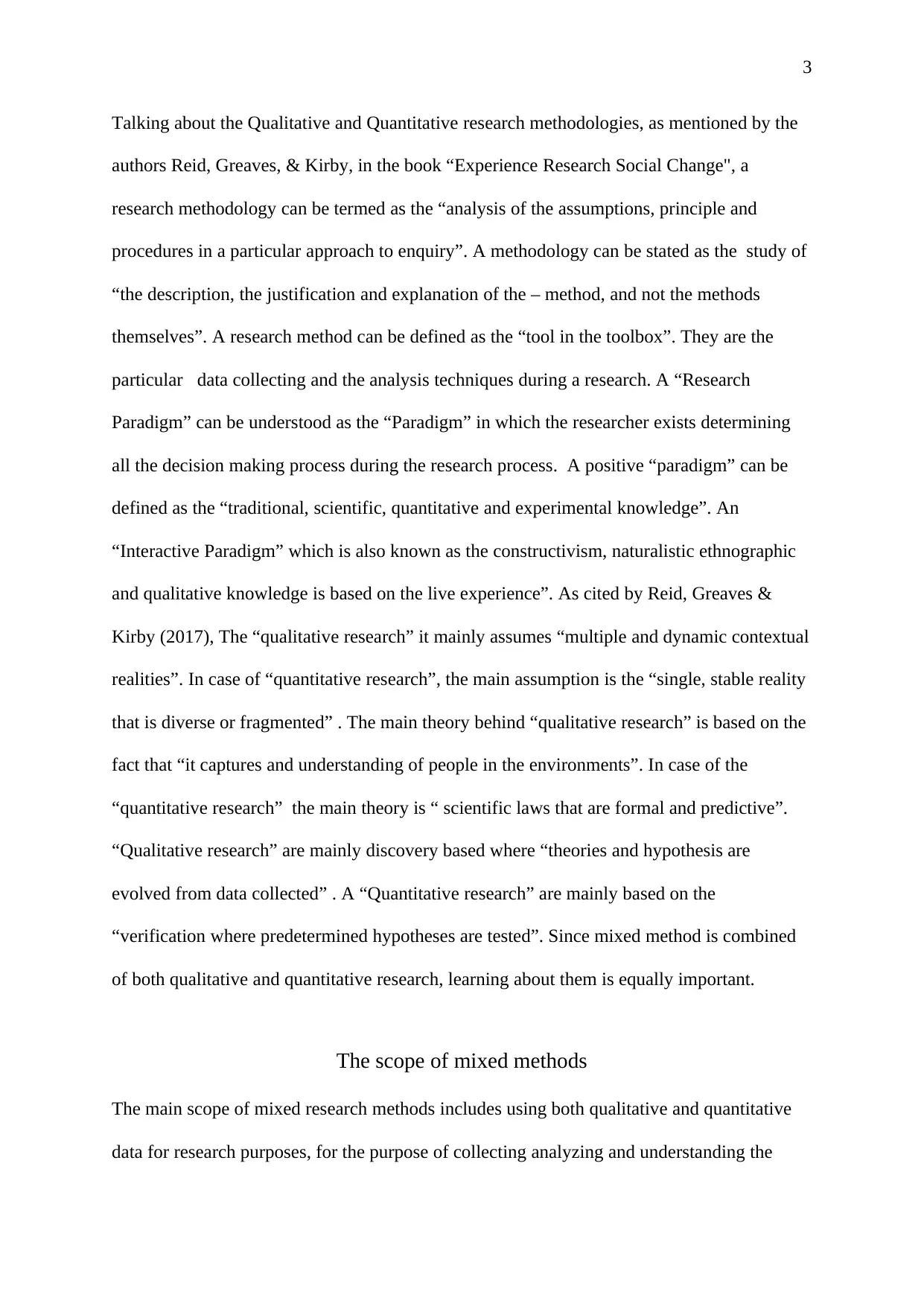
3
Talking about the Qualitative and Quantitative research methodologies, as mentioned by the
authors Reid, Greaves, & Kirby, in the book “Experience Research Social Change", a
research methodology can be termed as the “analysis of the assumptions, principle and
procedures in a particular approach to enquiry”. A methodology can be stated as the study of
“the description, the justification and explanation of the – method, and not the methods
themselves”. A research method can be defined as the “tool in the toolbox”. They are the
particular data collecting and the analysis techniques during a research. A “Research
Paradigm” can be understood as the “Paradigm” in which the researcher exists determining
all the decision making process during the research process. A positive “paradigm” can be
defined as the “traditional, scientific, quantitative and experimental knowledge”. An
“Interactive Paradigm” which is also known as the constructivism, naturalistic ethnographic
and qualitative knowledge is based on the live experience”. As cited by Reid, Greaves &
Kirby (2017), The “qualitative research” it mainly assumes “multiple and dynamic contextual
realities”. In case of “quantitative research”, the main assumption is the “single, stable reality
that is diverse or fragmented” . The main theory behind “qualitative research” is based on the
fact that “it captures and understanding of people in the environments”. In case of the
“quantitative research” the main theory is “ scientific laws that are formal and predictive”.
“Qualitative research” are mainly discovery based where “theories and hypothesis are
evolved from data collected” . A “Quantitative research” are mainly based on the
“verification where predetermined hypotheses are tested”. Since mixed method is combined
of both qualitative and quantitative research, learning about them is equally important.
The scope of mixed methods
The main scope of mixed research methods includes using both qualitative and quantitative
data for research purposes, for the purpose of collecting analyzing and understanding the
Talking about the Qualitative and Quantitative research methodologies, as mentioned by the
authors Reid, Greaves, & Kirby, in the book “Experience Research Social Change", a
research methodology can be termed as the “analysis of the assumptions, principle and
procedures in a particular approach to enquiry”. A methodology can be stated as the study of
“the description, the justification and explanation of the – method, and not the methods
themselves”. A research method can be defined as the “tool in the toolbox”. They are the
particular data collecting and the analysis techniques during a research. A “Research
Paradigm” can be understood as the “Paradigm” in which the researcher exists determining
all the decision making process during the research process. A positive “paradigm” can be
defined as the “traditional, scientific, quantitative and experimental knowledge”. An
“Interactive Paradigm” which is also known as the constructivism, naturalistic ethnographic
and qualitative knowledge is based on the live experience”. As cited by Reid, Greaves &
Kirby (2017), The “qualitative research” it mainly assumes “multiple and dynamic contextual
realities”. In case of “quantitative research”, the main assumption is the “single, stable reality
that is diverse or fragmented” . The main theory behind “qualitative research” is based on the
fact that “it captures and understanding of people in the environments”. In case of the
“quantitative research” the main theory is “ scientific laws that are formal and predictive”.
“Qualitative research” are mainly discovery based where “theories and hypothesis are
evolved from data collected” . A “Quantitative research” are mainly based on the
“verification where predetermined hypotheses are tested”. Since mixed method is combined
of both qualitative and quantitative research, learning about them is equally important.
The scope of mixed methods
The main scope of mixed research methods includes using both qualitative and quantitative
data for research purposes, for the purpose of collecting analyzing and understanding the
Paraphrase This Document
Need a fresh take? Get an instant paraphrase of this document with our AI Paraphraser
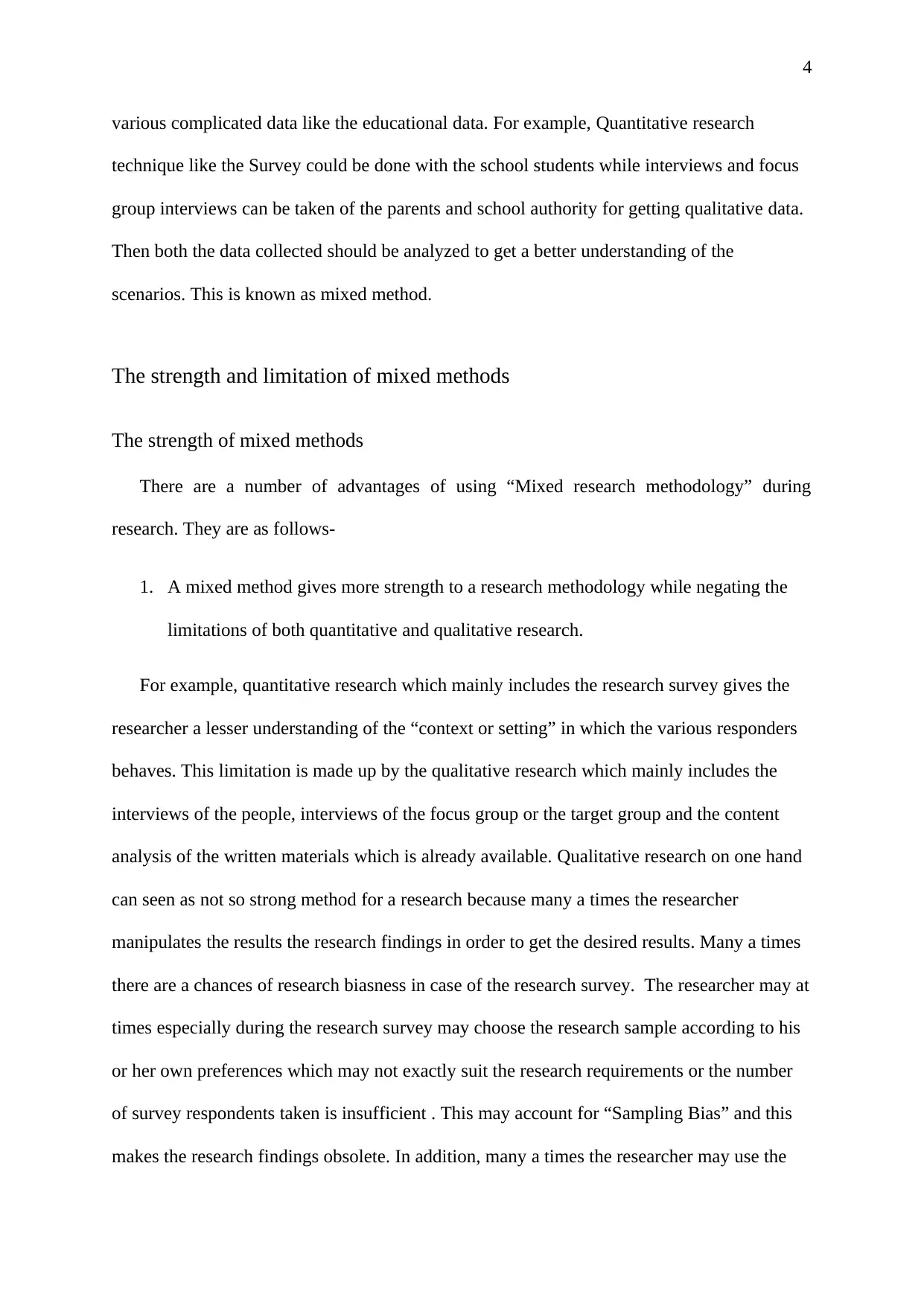
4
various complicated data like the educational data. For example, Quantitative research
technique like the Survey could be done with the school students while interviews and focus
group interviews can be taken of the parents and school authority for getting qualitative data.
Then both the data collected should be analyzed to get a better understanding of the
scenarios. This is known as mixed method.
The strength and limitation of mixed methods
The strength of mixed methods
There are a number of advantages of using “Mixed research methodology” during
research. They are as follows-
1. A mixed method gives more strength to a research methodology while negating the
limitations of both quantitative and qualitative research.
For example, quantitative research which mainly includes the research survey gives the
researcher a lesser understanding of the “context or setting” in which the various responders
behaves. This limitation is made up by the qualitative research which mainly includes the
interviews of the people, interviews of the focus group or the target group and the content
analysis of the written materials which is already available. Qualitative research on one hand
can seen as not so strong method for a research because many a times the researcher
manipulates the results the research findings in order to get the desired results. Many a times
there are a chances of research biasness in case of the research survey. The researcher may at
times especially during the research survey may choose the research sample according to his
or her own preferences which may not exactly suit the research requirements or the number
of survey respondents taken is insufficient . This may account for “Sampling Bias” and this
makes the research findings obsolete. In addition, many a times the researcher may use the
various complicated data like the educational data. For example, Quantitative research
technique like the Survey could be done with the school students while interviews and focus
group interviews can be taken of the parents and school authority for getting qualitative data.
Then both the data collected should be analyzed to get a better understanding of the
scenarios. This is known as mixed method.
The strength and limitation of mixed methods
The strength of mixed methods
There are a number of advantages of using “Mixed research methodology” during
research. They are as follows-
1. A mixed method gives more strength to a research methodology while negating the
limitations of both quantitative and qualitative research.
For example, quantitative research which mainly includes the research survey gives the
researcher a lesser understanding of the “context or setting” in which the various responders
behaves. This limitation is made up by the qualitative research which mainly includes the
interviews of the people, interviews of the focus group or the target group and the content
analysis of the written materials which is already available. Qualitative research on one hand
can seen as not so strong method for a research because many a times the researcher
manipulates the results the research findings in order to get the desired results. Many a times
there are a chances of research biasness in case of the research survey. The researcher may at
times especially during the research survey may choose the research sample according to his
or her own preferences which may not exactly suit the research requirements or the number
of survey respondents taken is insufficient . This may account for “Sampling Bias” and this
makes the research findings obsolete. In addition, many a times the researcher may use the
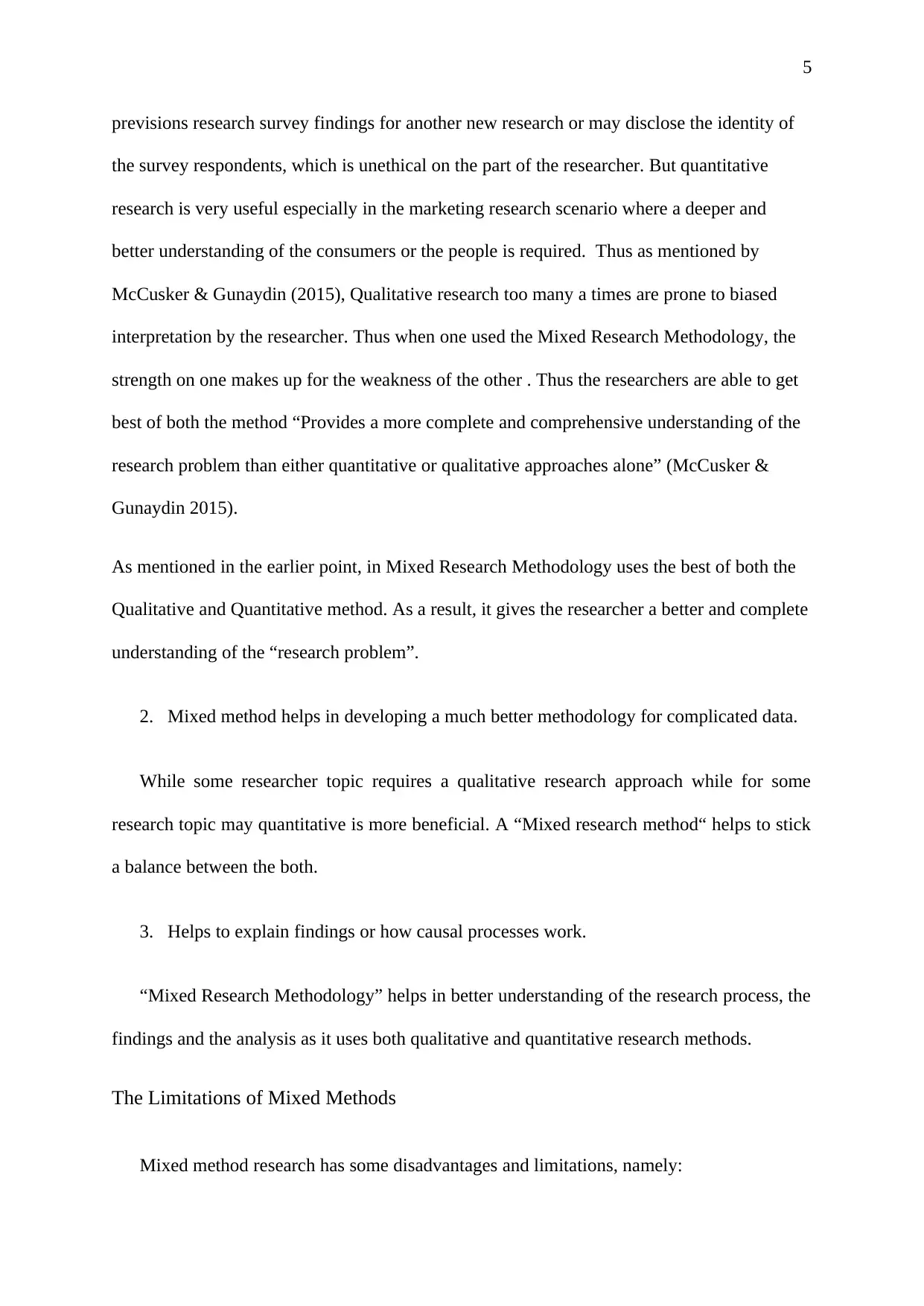
5
previsions research survey findings for another new research or may disclose the identity of
the survey respondents, which is unethical on the part of the researcher. But quantitative
research is very useful especially in the marketing research scenario where a deeper and
better understanding of the consumers or the people is required. Thus as mentioned by
McCusker & Gunaydin (2015), Qualitative research too many a times are prone to biased
interpretation by the researcher. Thus when one used the Mixed Research Methodology, the
strength on one makes up for the weakness of the other . Thus the researchers are able to get
best of both the method “Provides a more complete and comprehensive understanding of the
research problem than either quantitative or qualitative approaches alone” (McCusker &
Gunaydin 2015).
As mentioned in the earlier point, in Mixed Research Methodology uses the best of both the
Qualitative and Quantitative method. As a result, it gives the researcher a better and complete
understanding of the “research problem”.
2. Mixed method helps in developing a much better methodology for complicated data.
While some researcher topic requires a qualitative research approach while for some
research topic may quantitative is more beneficial. A “Mixed research method“ helps to stick
a balance between the both.
3. Helps to explain findings or how causal processes work.
“Mixed Research Methodology” helps in better understanding of the research process, the
findings and the analysis as it uses both qualitative and quantitative research methods.
The Limitations of Mixed Methods
Mixed method research has some disadvantages and limitations, namely:
previsions research survey findings for another new research or may disclose the identity of
the survey respondents, which is unethical on the part of the researcher. But quantitative
research is very useful especially in the marketing research scenario where a deeper and
better understanding of the consumers or the people is required. Thus as mentioned by
McCusker & Gunaydin (2015), Qualitative research too many a times are prone to biased
interpretation by the researcher. Thus when one used the Mixed Research Methodology, the
strength on one makes up for the weakness of the other . Thus the researchers are able to get
best of both the method “Provides a more complete and comprehensive understanding of the
research problem than either quantitative or qualitative approaches alone” (McCusker &
Gunaydin 2015).
As mentioned in the earlier point, in Mixed Research Methodology uses the best of both the
Qualitative and Quantitative method. As a result, it gives the researcher a better and complete
understanding of the “research problem”.
2. Mixed method helps in developing a much better methodology for complicated data.
While some researcher topic requires a qualitative research approach while for some
research topic may quantitative is more beneficial. A “Mixed research method“ helps to stick
a balance between the both.
3. Helps to explain findings or how causal processes work.
“Mixed Research Methodology” helps in better understanding of the research process, the
findings and the analysis as it uses both qualitative and quantitative research methods.
The Limitations of Mixed Methods
Mixed method research has some disadvantages and limitations, namely:
⊘ This is a preview!⊘
Do you want full access?
Subscribe today to unlock all pages.

Trusted by 1+ million students worldwide

6
1. Complex research design when compared to individual qualitative and quantitative
research method.
Many a times the use of Mixed Research Methodology makes an overall research
design very complicated.
2. A mixed method requires more time, effort and resources.
As Mixed Research Method includes both qualitative and quantitative research,
completion of the whole research process takes bit longer than the rest.
3. “It may be difficult to plan and implement one method by drawing on the findings of
another.”
Since both qualitative and quantitative research methods are used in mixed method, a
research needs to find both the data and then analysis to derive proper conclusion.
4. “It may be unclear how to resolve discrepancies that arise in the interpretation of the
findings”.
Summary
Mixed methods in research has both advantage and disadvantage. Based on the research
requirement and topic, the researcher must decide upon the research method. The mixed
method is more effective especially in situation like analyzing the difficult educational data.
1. Complex research design when compared to individual qualitative and quantitative
research method.
Many a times the use of Mixed Research Methodology makes an overall research
design very complicated.
2. A mixed method requires more time, effort and resources.
As Mixed Research Method includes both qualitative and quantitative research,
completion of the whole research process takes bit longer than the rest.
3. “It may be difficult to plan and implement one method by drawing on the findings of
another.”
Since both qualitative and quantitative research methods are used in mixed method, a
research needs to find both the data and then analysis to derive proper conclusion.
4. “It may be unclear how to resolve discrepancies that arise in the interpretation of the
findings”.
Summary
Mixed methods in research has both advantage and disadvantage. Based on the research
requirement and topic, the researcher must decide upon the research method. The mixed
method is more effective especially in situation like analyzing the difficult educational data.
Paraphrase This Document
Need a fresh take? Get an instant paraphrase of this document with our AI Paraphraser

7
References
Almalki, S. (2016). Integrating Quantitative and Qualitative Data in Mixed Methods
Research--Challenges and Benefits. Journal of Education and Learning, 5(3), 288-
296.
Creswell, J. W. (2014). A concise introduction to mixed methods research. SAGE
publications.
Edmonds, W. A., & Kennedy, T. D. (2016). An applied guide to research designs:
Quantitative, qualitative, and mixed methods. Sage Publications.
McCusker, K., & Gunaydin, S. (2015). Research using qualitative, quantitative or mixed
methods and choice based on the research. Perfusion, 30(7), 537-542.
Mertens, D. M. (2014). Research and evaluation in education and psychology: Integrating
diversity with quantitative, qualitative, and mixed methods. Sage publications.
Molina-Azorin, J. F. (2016). Mixed methods research: An opportunity to improve our studies
and our research skills.
Morse, J. M. (2016). Mixed method design: Principles and procedures. Routledge.
Ponce, O. A., & Pagán-Maldonado, N. (2015). Mixed methods research in education:
Capturing the complexity of the profession. International Journal of Educational
Excellence, 1(1), 111-135.
Terrell, S. R. (2012). Mixed-methods research methodologies. The qualitative report, 17(1),
254-280.
References
Almalki, S. (2016). Integrating Quantitative and Qualitative Data in Mixed Methods
Research--Challenges and Benefits. Journal of Education and Learning, 5(3), 288-
296.
Creswell, J. W. (2014). A concise introduction to mixed methods research. SAGE
publications.
Edmonds, W. A., & Kennedy, T. D. (2016). An applied guide to research designs:
Quantitative, qualitative, and mixed methods. Sage Publications.
McCusker, K., & Gunaydin, S. (2015). Research using qualitative, quantitative or mixed
methods and choice based on the research. Perfusion, 30(7), 537-542.
Mertens, D. M. (2014). Research and evaluation in education and psychology: Integrating
diversity with quantitative, qualitative, and mixed methods. Sage publications.
Molina-Azorin, J. F. (2016). Mixed methods research: An opportunity to improve our studies
and our research skills.
Morse, J. M. (2016). Mixed method design: Principles and procedures. Routledge.
Ponce, O. A., & Pagán-Maldonado, N. (2015). Mixed methods research in education:
Capturing the complexity of the profession. International Journal of Educational
Excellence, 1(1), 111-135.
Terrell, S. R. (2012). Mixed-methods research methodologies. The qualitative report, 17(1),
254-280.
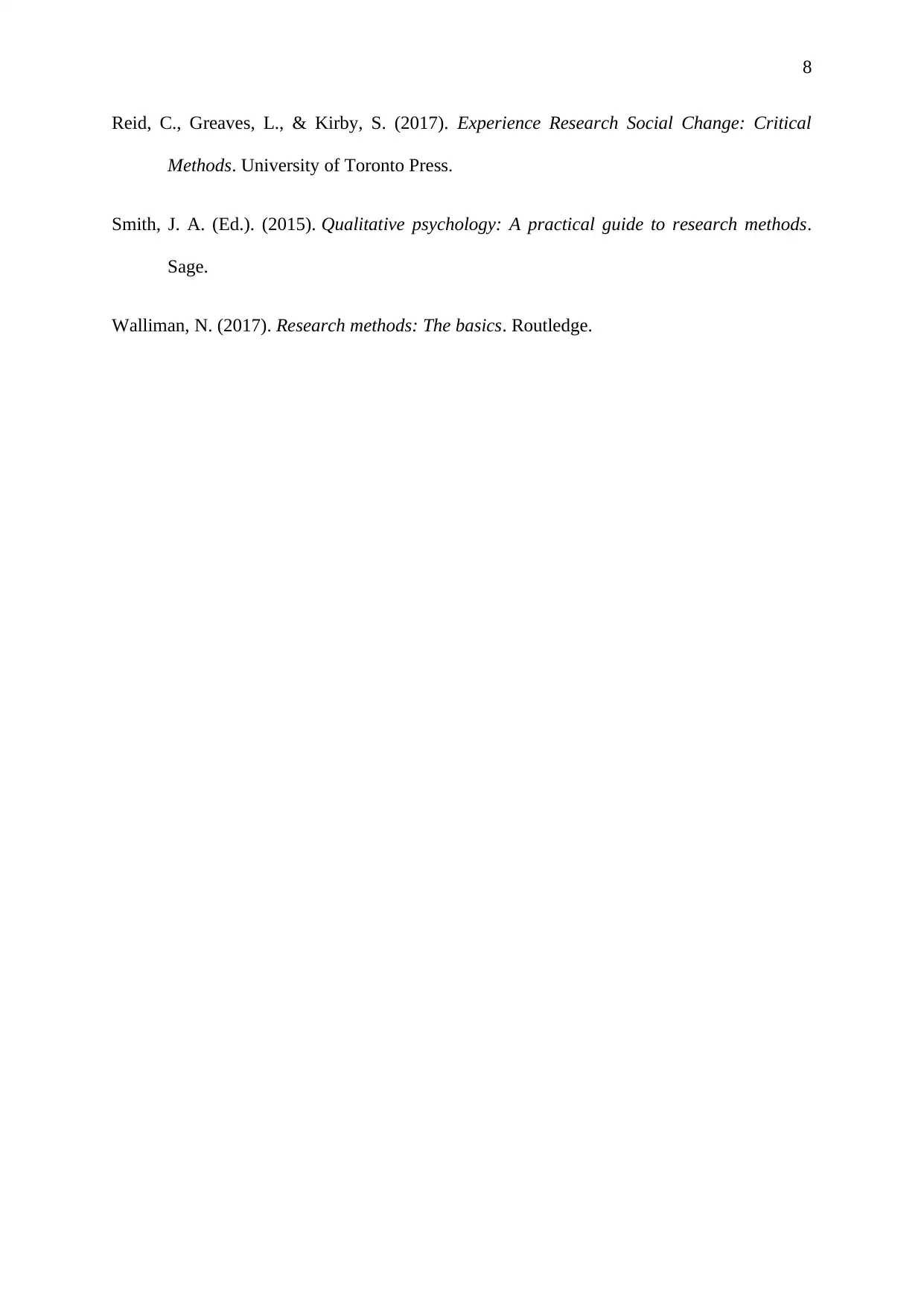
8
Reid, C., Greaves, L., & Kirby, S. (2017). Experience Research Social Change: Critical
Methods. University of Toronto Press.
Smith, J. A. (Ed.). (2015). Qualitative psychology: A practical guide to research methods.
Sage.
Walliman, N. (2017). Research methods: The basics. Routledge.
Reid, C., Greaves, L., & Kirby, S. (2017). Experience Research Social Change: Critical
Methods. University of Toronto Press.
Smith, J. A. (Ed.). (2015). Qualitative psychology: A practical guide to research methods.
Sage.
Walliman, N. (2017). Research methods: The basics. Routledge.
⊘ This is a preview!⊘
Do you want full access?
Subscribe today to unlock all pages.

Trusted by 1+ million students worldwide
1 out of 9
Related Documents
Your All-in-One AI-Powered Toolkit for Academic Success.
+13062052269
info@desklib.com
Available 24*7 on WhatsApp / Email
![[object Object]](/_next/static/media/star-bottom.7253800d.svg)
Unlock your academic potential
Copyright © 2020–2025 A2Z Services. All Rights Reserved. Developed and managed by ZUCOL.





